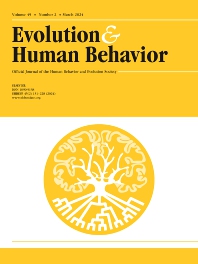Journals in Evolutionary ecology
Journals in Evolutionary ecology
Evolution and Human Behavior
Official Journal of the Human Behavior and Evolution Society Members of the Society receive reduced cost subscriptions to the journal.Evolution and Human Behavior is an interdisciplinary journal, presenting research reports and theory in which evolutionary perspectives are brought to bear on the study of human behavior. It is primarily a scientific journal, but submissions from scholars in the humanities are also encouraged. Papers reporting on theoretical and empirical work on other species will be welcome if their relevance to the human animal is apparent.- ISSN: 1090-5138

Trends in Ecology & Evolution
Trends in Ecology & Evolution (TREE) contains polished, concise and readable reviews, opinions and letters in all areas of ecology and evolutionary science. It serves as an invaluable source of information for researchers, lecturers, teachers, field workers and students. Trends in Ecology & Evolution keeps these scientists informed of new developments and ideas across the full range of ecology and evolutionary biology - from the pure to the applied, and from molecular to global. Now, more than ever before, is it necessary for life scientists to be aware of research from a wide range of disciplines, especially in the face of the gathering momentum of global environmental change and destruction. More than any other journal, Trends in Ecology & Evolution is the major forum for coverage of all the important issues concerning organisms and their environments.Article... for Trends in Ecology & Evolution are a mix of those commissioned by the Editor and ideas from the authors. Prospective authors should submit a Proposal as outlined at https://www.cell.com... by email to the Editor, Andrea Stephens ([email protected]). The submission of completed manuscripts without prior consultation with the Editor is strongly discouraged. Authors should note that all major articles in TREE are peer-reviewed and publication cannot be guaranteed.Visit the Cell Press website for more information about Trends in Ecology & Evolution - http://www.cell.com/...- ISSN: 0169-5347

Comparative Biochemistry and Physiology - Part B: Biochemistry & Molecular Biology
Comparative Biochemistry & Physiology (CBP) publishes papers in comparative, environmental and evolutionary physiology.Part B: Biochemical and Molecular Biology (CBPB), focuses on biochemical physiology, primarily bioenergetics/energy metabolism, cell biology, cellular stress responses, enzymology, intermediary metabolism, macromolecular structure and function, gene regulation, evolutionary genetics. Most studies focus on biochemical or molecular analyses that have clear ramifications for physiological processes.All four CBP journals support and follow the editorial direction from all the major societies in the field:Australia & New Zealand Society of Comparative Physiology and Biochemistry (ANZSCPB)American Physiological Society (APS)Canadian Society of Zoologists (CSZ)Deutsche Zoologische Gesellschaft (DZG)European Society of Comparative Physiology and Biochemistry (ESCPB)Japanese Society for Comparative Physiology and Biochemistry (JSCPB)South American Society for Comparative Physiology and Biochemistry (SASCPB)Societe de Physiologie (SDP)Society for Experimental Biology (SEB)Society for Integrative & Comparative Biology (SICB)CBP journals are focused on promoting the authors and the work published in the journal:All articles are carefully evaluated directly by the Editors-in-Chief who are leading experts in their field.Availability: contact the Editor-in-Chief for any questions you may have.The Journal will provide upon request free PDFs to all authors who may not have access to their articles via their institution or library.Publication is free to authors (no color or page charges).Supporting open access: if your funding body or institution requires your article to be open access, CBP offers that option. Please see details here.Reuse figures from any CBP article via "get rights and content" hyperlink available within each article (below author names and affiliations) on ScienceDirect.Please click here for more information on more general author services.Other CBP journals Part A (CBPA): Molecular & Integrative Physiology Part C (CBPC): Toxicology & Pharmacology Part D (CBPD): Genomics and Proteomics- ISSN: 1096-4959
